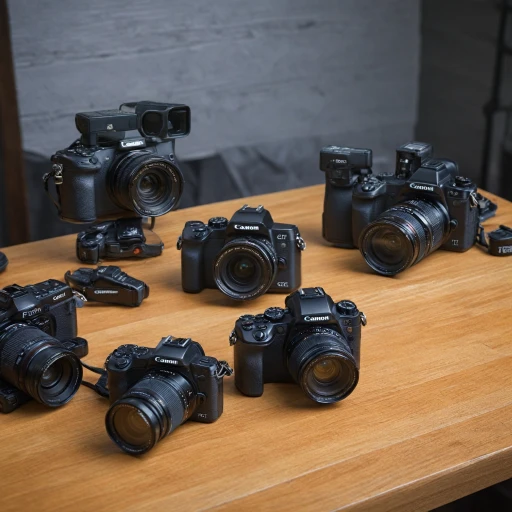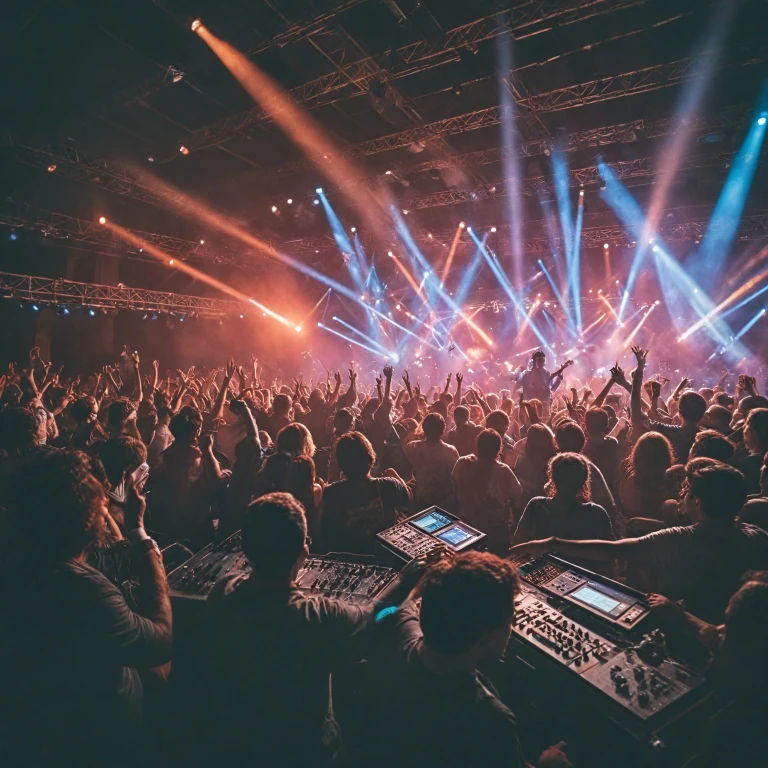Understanding the Challenges of Live Band Photography
Capturing the Energy of Live Performances
Shooting live bands poses a unique challenge for photographers. Unlike studio photography, the dynamic environment of a concert requires a camera that can handle unpredictability and rapid changes in lighting and movement. When you're in the midst of pulsating music and swirling lights, the right camera will make all the difference.
One of the primary challenges is working with low light conditions. Concert venues often rely on dramatic, colorful lighting that can vary from moment to moment. A camera with excellent low light capabilities, such as a Sony or a Canon EOS, is essential for maintaining image quality in these settings. The dynamic range and ability to capture details in both bright and dark areas will greatly affect the outcome of your photos.
The fast-paced nature of live music also requires a camera with quick autofocus and high-speed continuous shooting capabilities. Whether you're using a full frame or a mirrorless camera, the ability to swiftly capture continuous action without lag is critical. You'll also appreciate a silent shooting mode to avoid disturbing the atmosphere of a live performance.
The energy of the concert is not only captured in stills; video recording of live performances is equally important. Choosing a video camera that excels in shooting video with high-quality footage is crucial. Cameras like the Panasonic Lumix are often praised for their video capabilities, offering both good quality and adaptable shooting options.
For those who are considering diving deeper into the intricacies of concert photography, exploring
unique perspectives on digital photography can provide added inspiration and depth to your approach.
In the end, understanding the challenges of live band photography will set the foundation for selecting the best camera and enhancing your concert photography skills.
Key Features to Look for in a Camera
Essential Camera Traits for Live Music Photography
When it comes to live music photography, choosing the right camera can make all the difference. Notably, low-light conditions at concerts pose a unique challenge, impacting image quality. Therefore, it's crucial to prioritize cameras with superior low-light performance and features that cater to capturing the dynamic atmosphere of live performances.
Low-light Performance
Concert venues often have dim lighting, making it essential to select a camera that excels in these conditions. Full frame cameras, such as the Canon EOS or the Nikon range, are renowned for their large sensors, offering excellent sensitivity in low-light scenarios. The dynamic range these cameras provide enhances contrast, capturing the essence of live music.
Fast Shutter Speed for Action Shots
Capturing musicians in action demands a camera with a fast shutter speed to freeze movement and reduce motion blur. Cameras from brands like Canon and Sony are equipped with features that allow precise control over shooting settings, ensuring you never miss an electrifying moment on stage.
Video Capabilities for Multi-purpose Use
Increasingly, video production has become an integral aspect of music photography. When considering a camera, evaluate its video recording functionality. Models like the Panasonic Lumix are popular for their video capacity, offering smooth footage for music videos and live streaming.
Mirrorless Cameras for Versatility
For those seeking versatility, mirrorless cameras provide a compact yet powerful option. With brands like Sony at the forefront, these cameras offer high performance without the bulk, ideal for maneuvering through crowded venues.
For further insights into equipment considerations and accessories perfect for music photography enthusiasts, consider exploring this
thoughtful gifts for photography enthusiasts guide.
In summary, selecting a camera with strong low-light performance, fast shutter speed, and reliable video capabilities will vastly improve your concert photography experience. Your choice of camera will significantly influence the quality and impact of your concert images.
Top Camera Models for Live Music Photography
Leading Cameras Capturing the Emotion of Live Music
When it comes to concert photography and videography, certain camera models stand out due to their ability to handle challenging environments. The key players in the market, known for their exceptional image quality and dynamic range, are primarily from Canon, Nikon, Sony, and Panasonic.
- Canon EOS Line: Canon EOS cameras, specifically the Canon Mark series, are renowned for capturing high-quality images even in low-light conditions typical of concerts. Their full-frame sensors and advanced processing engines make it easier to record top-notch concert footage.
- Sony Mirrorless Cameras: Sony's mirrorless models are known for their outstanding performance in both photography and shooting video in dim light settings. They are great for those keen on live streaming or capturing music videos during performances, with their impressive shutter speed and superb video recording capabilities.
- Nikon DSLRs and Mirrorless Options: Known for their sturdy build and excellent handling, these cameras deliver high-performance shooting with fast autofocus systems and reliable image stabilization—crucial for shooting fast-moving subjects in music environments.
- Panasonic Lumix Series: For a focus on videos, the Panasonic Lumix cameras boast features that cater specifically to videographers, offering advanced video camera functionalities like 4K video, making them perfect for capturing live band performances.
Understanding the differences between mirrorless and DSLR cameras can further guide your decision-making on which camera will suit your needs best when
capturing the high energy of live concerts. Each brand and type offer specific advantages, and selecting the right one will significantly impact the quality of your concert photography and videos.
Lens Selection for Concert Photography
Choosing the Right Lens for Captivating Concert Shots
Choosing the right lens is crucial in concert photography, especially in low light environments typically found in live music venues. The ability to capture clear, sharp images while managing the challenging lighting conditions is essential.
A wide aperture lens is a key tool for any photographer shooting at concerts. These lenses allow more light to hit the camera's sensor, which is vital for shooting in dimly lit conditions. Lenses with apertures of f/2.8 or wider are often preferable, as they help to ensure the best image quality possible when dealing with low light.
Both prime and zoom lenses have their advantages in concert settings. Prime lenses, like a 50mm f/1.8, offer excellent quality and allow for shooting even in the most challenging lighting. Meanwhile, zoom lenses offer flexibility, enabling photographers to adapt to varying distances and angles without needing to change lenses.
Considerations:
- Focal Length: A versatile focal range, such as 24-70mm, is often recommended for concert shooting. It provides flexibility in framing shots from close-ups to group ensembles.
- Brand Compatibility: Ensure the lens is compatible with your camera brand. For Canon EOS users, Canon lenses are a natural fit, but Sigma and Tamron offer quality options as well. Nikon, Sony, and Panasonic Lumix cameras also have excellent native lenses.
- Fast Autofocus and Image Stabilization: In dynamic concert environments where subjects are constantly moving, these features can make a significant difference in capturing sharply focused shots and videos.
Ultimately, the choice of lens will depend on the specific preferences and style of the photographer, as well as the concert setting and lighting conditions. Selecting a lens that complements a mirrorless camera or DSLR will ensure the highest image quality and help in making those unforgettable concert moments stand out.
Tips for Capturing the Best Shots at Concerts
Maximizing Your Concert Photography Techniques
Mastering concert photography requires more than just having the best camera or lens. It's about knowing how to use your equipment effectively in dynamic conditions.
- Understand the Venue Lighting: Every concert venue has its unique lighting setup. Familiarize yourself with the stage lights and anticipate their changes. This will help in setting your camera to the appropriate shutter speed and ISO settings to capture clear images despite the low light.
- Use the Right Shooting Mode: In such unpredictable conditions, a mirrorless camera with a reliable autofocus system can make a world of difference. Consider shooting in manual mode to have full control over your settings, or use aperture priority to maintain a consistent depth of field.
- Keep an Eye on Shutter Speed: Since bands can move quickly across the stage, maintaining a fast shutter speed is essential to prevent motion blur. Adjust accordingly based on the movement and lighting conditions.
- Leverage Continuous Shooting: Taking advantage of your camera's continuous shooting mode will help capture a sequence of shots during rapid movements or intense musical moments. This is useful when shooting video as well, especially with cameras like the Canon EOS that excel in video recording.
- Positioning is Key: Arrive early to secure a good spot that offers a clear view of the stage. Being close to the stage helps capture the performers' expressions and interactions while using longer lenses if further away.
Remember, experimenting with different techniques and adapting to each concert’s vibe is essential. Every show will give you a chance to hone your skills further, and the more you shoot in live music environments, the better your image quality and dynamic range will become.
Post-Processing Tips for Concert Photos
Enhancing Your Concert Photos Through Editing
Whether you've captured images on a Canon EOS, a Nikon, or any other leading model, effective post-processing can turn your good concert photos into great ones. Here are some key tips to consider:
- Adjust Exposure and Contrast: Concerts often have variable lighting. Use software like Adobe Lightroom to correct exposure. Adjust contrast to make your subjects stand out in the midst of dynamic lighting.
- Tweak the Colors: Concert lighting can be harsh and colored. White balance should be adjusted to make sure colors look natural. Software like Photoshop offers powerful color correction tools for this.
- Sharpen Your Images: Sharpening your photos can enhance detail, especially in low-light conditions common during concerts. Be cautious, though, as too much sharpening can introduce noise.
- Reduce Noise: With many digital cameras, shooting in low light might cause noise. Utilizing noise reduction tools can help maintain image quality without compromising detail.
- Crop for Composition: Often concert shots have distractions. Cropping can help focus on the main subject, enhancing the storytelling aspect of music photography.
- Explore Black and White Editing: Sometimes, concert photos look striking in black and white, accentuating the dynamic range and mood. Experimenting with this can give your images a classic feel.
By focusing on these editing strategies, you can ensure your music photos and videos resonate with quality and impact, capturing the electrifying experience of live band performances.

